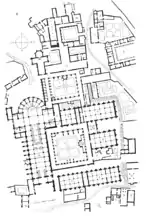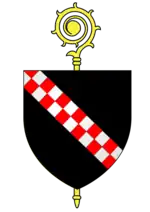 Main façade of the abbey | |
 Location within France | |
| Monastery information | |
|---|---|
| Order | Cistercian |
| Established | 1115 |
| Mother house | Cîteaux Abbey |
| People | |
| Founder(s) | Bernard of Clairvaux |
| Site | |
| Location | Ville-sous-la-Ferté, France |
| Coordinates | 48°08′50″N 4°47′20″E / 48.14722°N 4.78889°E |
| Visible remains | substantial |
| Public access | yes |
Clairvaux Abbey (/klɛərˈvoʊ/, French: [klɛʁvo]; Latin: Clara Vallis) was a Cistercian monastery in Ville-sous-la-Ferté, 15 kilometres (9.3 mi) from Bar-sur-Aube. The original building, founded in 1115 by Bernard of Clairvaux, is now in ruins; the present structure dates from 1708.[1] Clairvaux Abbey was a good example of the general layout of a Cistercian monastery. The abbey has been listed since 1926 as a historical monument by the French Ministry of Culture.
The grounds are now occupied and used by Clairvaux Prison, a high-security prison.
History
In 1115, Bernard, a Benedictine monk of the Abbaye de Saint-Nicolas-lès-Cîteaux, was sent with a group of twelve other monks to found a new house at Vallée d'Absinthe.[2] Hughes I, Count of Troyes, donated this valley to the colony of Cistercians.[3] The Cistercians sought places both remote from the world, to be able to devote themselves to prayer, and well served by natural resources, to be entirely self-sufficient. Bernard was installed as first abbot by William of Champeaux, Bishop of Châlons-sur-Marne.[4]
Under his direction, the abbey developed rapidly. In 1118 Trois-Fontaines Abbey was founded from Clairvaux on land donated by Hugh de Vitry. It quickly became the largest Cistercian abbey in France.[5]
Foigny Abbey was founded in 1121 by Bernard and Barthélemy of Jur, bishop of Laon. Cherlieu Abbey was founded in 1131 with the support of Renaud III, Count of Burgundy. During Bernard's lifetime sixty-eight monasteries were founded from Clairvaux in France, Italy, Germany, England, Spain, and Portugal.[3]
After two centuries of fervour, Clairvaux did not escape decline. But it was one of the first to reform. In 1615, Abbot Denis Largentier restored the fasts, abstinences and other practices of the order. In 1790 Clairvaux had in affiliation in France ninety-two houses with 864 religious. This abbey had given to the Church one pope, Eugene III, fifteen cardinals, and a great number of archbishops and bishops. At the time of the Revolution Clairvaux had only 26 professed religious, counting the abbot, Louis-Marie Rocourt, 10 lay brothers, and 10 affiliated pensioners of the house; 19 of the religious and all the lay brothers were secularized. Clairvaux became the property of the State, and its buildings were converted into a prison.
Description

Cistercian monasteries were all arranged according to a set plan unless the circumstances of the locality forbade it. A strong wall, furnished at intervals with watchtowers and other defenses, surrounded the abbey precincts. Beyond it a moat, artificially diverted from tributaries which flow through the precincts, completely or partially encircled the wall. This water furnished the monastery with an abundant supply of water for irrigation, sanitation, and for the use of the offices and workshops.
An additional wall, running from north to south, bisected the monastery into an "inner" and "outer" ward. The inner ward housed the monastic buildings, while the agricultural and other artisan endeavors were carried out in the outer ward.
The precincts were entered by a gateway at the extreme western extremity, giving admission to the lower ward. Here the barns, granaries, stables, shambles (slaughtering yard), workshops, and workmen's lodgings were located. Convenience was the only consideration for design. A single gatehouse afforded communication through the wall separating the outer from the inner ward.

On passing through the gateway, monks and visitors entered the outer court of the inner ward, to face the western facade of the monastic church. Immediately to the right of entrance was the abbot's residence, in close proximity to the guest-house. On the other side of the court were stables for the accommodation of the horses of the guests and their attendants. The church occupied a central position, with the great cloister to the south, surrounded by the chief monastic buildings. Further to the east, the smaller cloister contained the infirmary, novices' lodgings, and quarters for the aged monks. Beyond the smaller cloister, and separated from the monastic buildings by a wall, lay the vegetable gardens and orchards. The location made it possible to create mills and fish ponds and use the forest for timber and raising livestock.[6] Large fish ponds were also located in the area east of the monastic buildings. The ponds were an important feature of monastic life, and much care was given by the monks to their construction and maintenance. They often remain as one of the few visible traces of these vast monasteries.
The church consists of a vast nave of eleven bays, entered by a narthex, with a transept and short apsidal choir. To the east of each limb of the transept are two square chapels, divided according to Cistercian rule by solid walls. Nine radiating chapels, similarly divided, surround the apse. The stalls of the monks occupy the four eastern bays of the nave, forming the ritual choir. There was a second range of stalls in the extreme western bays of the nave for the lay brothers. The cloister was located to the south of the church so that its inhabitants could benefit from ample sunshine.
The chapter house opened out of the east walk of the cloister in parallel with the south transept.
List of abbots
- 1115–1153 — Bernard I[4]
- 1153–1157 — Robert I of Bruges
- 1157-vers 1161 — Fastradus
- 1162–1165 — Geoffrey of Auxerre
- 1165–1170 — Pons of Polignac
- 1170–1175 — Gerard I
- 1176–1179 — Henry of Marcy
- 1179–1186 — Peter I Monoculus
- 1186–1193 — Garnier de Rochefort
- 1193–1196 — Guy of France
- c. 1214–1216 — Conrad I of Urach
- 1217–1221 — William I
- 1221–1223 — Robert II
- 1223–1224 — Lawrence
- 1224–1232 — Raoul de la Roche-Aymon
- 1233–1235 — Dreux de Grandmont
- 1235–1238 — Evrard
- 1238–1239 — William of Dongelberg
- 1242–1255 — Stephen I of Lexington
- 1257–1260 or 1261 — John I
- 1262–1273 — Philip I
- 1273–1280 — Beuve
- 1280–1284 — Thibaud de Sancey
- 1284–1285 — Gerard II
- 1286–1291 — Jean II de La Prée
- 1291–1312 — Jean III de Sancey
- 1312 — William III
- 1313–1316 — Conrad II of Metz
- 1316–1330 — Mathieu I d'Aumelle
- 1330–1345 — Jean IV d'Aizanville
- 1345–1358 — Bernard II de Laon
- 1358–1359 — Jean V de Bussières
- 1363–1380 — Jean VI de Deulemont
- 1380–1402 — Étienne II de Foissy
- 1402–1405 — Jean VII de Martigny
- 1405–1428 — Mathieu II Pillaert
- 1428–1448 — Guillaume IV d'Autun
- 1449–1471 — Philippe II de Fontaines
- 1471–1496 — Pierre II de Virey
- 1496–1509 — Jean VIII de Foucault
- 1509–1552 — Edmond de Saulieu
- 1552–1571 — Jérôme Souchier
- 1571–1596 — Lupin Lemire
- 1596–1626 — Denis Largentier
- 1626–1653 — Claude Largentier
- 1654–1676 — Pierre III Henry
- 1676–1718 — Pierre IV Bouchu
- 1718–1740 — Robert III Gassot du Deffend
- 1740–1761 — Pierre V Mayeur
- 1761–1784 — François Le Blois
- 1784–1792 — Louis-Marie Rocourt
Burials
See also
- List of abbeys and priories
- Chiaravalle Abbey
- Claraval in Brazil: the same name in Portuguese; also the seat of a former Abbacy nullius
References
- ↑ Leroux-Dhuys, Jean-François (12 June 2012). "Clairvaux : de l'abbaye à la prison". La Marche de l'Histoire (in French). France Inter.
- ↑ Bunson, Matthew; Bunson, Margaret & Bunson, Stephen. Our Sunday Visitor's Encyclopedia of Saints. (1998) Huntington: Our Sunday Visitor. p. 129
- 1 2 3 Gildas, Marie. "Abbey of Clairvaux." The Catholic Encyclopedia Vol. 3. New York: Robert Appleton Company, 1908. 17 December 2022
 This article incorporates text from this source, which is in the public domain.
This article incorporates text from this source, which is in the public domain. - 1 2 Gildas, Marie. "St. Bernard of Clairvaux." The Catholic Encyclopedia Vol. 2. New York: Robert Appleton Company, 1907. 17 December 2022
 This article incorporates text from this source, which is in the public domain.
This article incorporates text from this source, which is in the public domain. - ↑ Maurot, Élodie. "French state looking to 'sell' the former Clairvaux Abbey", La Croix International, December 2, 2022
- ↑ "The Abbey", Clairvaux 2022
![]() This article incorporates text from a publication now in the public domain: Herbermann, Charles, ed. (1913). "Abbey of Clairvaux". Catholic Encyclopedia. New York: Robert Appleton Company.
This article incorporates text from a publication now in the public domain: Herbermann, Charles, ed. (1913). "Abbey of Clairvaux". Catholic Encyclopedia. New York: Robert Appleton Company.